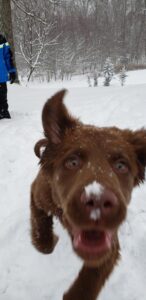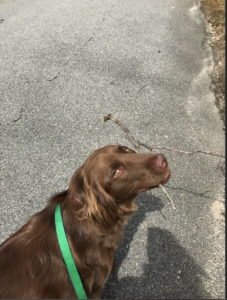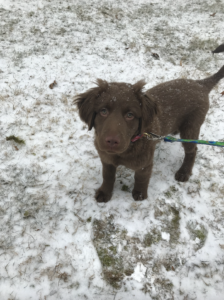
Chewie in the Snow
Being an Australian Shepherd-Chocolate Lab mix, you would think that Chewie is a water-loving dog. Quite the opposite actually- he is severely afraid of it. While my family is swimming in the 90 degree weather, Chewie lays inside on the air conditioning vent, huffing every time it turns off. However, put him outside in the snow and, while you freeze your butt off, he will stay there all day. I never understood the appeal of the cold. I always wondered if dogs have any special adaptations for cold weather survival. There’s an article called Role of Brown and Beige Adipose Tissues in Seasonal Adaptation in the Raccoon Dog (Nyctereutes procyonoides) written by Laura Niiranen and many other authors. In this article, they obtain CT scans of three racoon dogs. Now while there was a lot of information that I didn’t understand, they did talk about a couple of different tissues that contribute to cold weather resilience.
In this article, an animal called a raccoon dog, or Nyctereutes procyonoides, were tested to see what in their body is utilized to produce heat in the winter. The racoon dog, like other animals, is a species that uses weight gain during cold seasons to survive periods of food shortage (Niiranen et al. 2021). Niiranen and other researchers wanted to know if this species additionally used tissues to produce heat. These tissues, I thought, could be the reason Chewie loves the cold so much. Adipose tissue- used to store heat in the body- contributes to maintaining body heat during the cold seasons. In this study, Brown Adipose Tissue (BAT) was “not detected in the adult raccoon dog during the winter season” (Niiranen et al. 2021). I thought, just because this species of canid doesn’t use it for warmth in the winter, doesn’t mean Chewie can’t.
 BAT is a tissue that expresses a protein called “uncoupling protein-1 (UCP1)”. This protein allows energy to go towards the production of heat in the body (Niiranen et al. 2021). UCP1 “uncouples the mitochondrial oxidative phosphorylation from ATP synthesis” (Niiranen et al. 2021) which, in simple terms, means it allows the release of energy in the form of heat. Chewie, because he is a pet, and we as the owners control his diet, does not use “seasonal obesity” to keep himself warm, even though I know he would be very happy to eat more food. This means there has to be something else at play. I really believe he has evolved to use something like BAT to keep him warm; but… what if it never “stops”?
BAT is a tissue that expresses a protein called “uncoupling protein-1 (UCP1)”. This protein allows energy to go towards the production of heat in the body (Niiranen et al. 2021). UCP1 “uncouples the mitochondrial oxidative phosphorylation from ATP synthesis” (Niiranen et al. 2021) which, in simple terms, means it allows the release of energy in the form of heat. Chewie, because he is a pet, and we as the owners control his diet, does not use “seasonal obesity” to keep himself warm, even though I know he would be very happy to eat more food. This means there has to be something else at play. I really believe he has evolved to use something like BAT to keep him warm; but… what if it never “stops”?
 Chewie is always panting, even in the winter, and never stays on the sofa for more than an hour. The hardwood floors are his favorite place besides the AC vents. As much as he loves being outside, Chewie can’t stay out in the sun for more than 15 minutes in the summer. These things really get me thinking. I want to learn more about heat producing tissues like BAT and what causes them to release heat. I want to know if dogs have evolved to keep themselves warm, and if they did, what caused this? I would love to dive further into this in the future.
Chewie is always panting, even in the winter, and never stays on the sofa for more than an hour. The hardwood floors are his favorite place besides the AC vents. As much as he loves being outside, Chewie can’t stay out in the sun for more than 15 minutes in the summer. These things really get me thinking. I want to learn more about heat producing tissues like BAT and what causes them to release heat. I want to know if dogs have evolved to keep themselves warm, and if they did, what caused this? I would love to dive further into this in the future.
- Niiranen, L., Mäkelä, K. A., Mutt, S. J., Viitanen, R., Kaisanlahti, A., Vicente, D., Noponen, T., Autio, A., Roivainen, A., Nuutila, P., Saarela, S., & Herzig, K. H. (2021). Role of Brown and Beige Adipose Tissues in Seasonal Adaptation in the Raccoon Dog (Nyctereutes procyonoides). International journal of molecular sciences, 22(17), 9623. https://doi.org/10.3390/ijms22179623

Leave a Reply